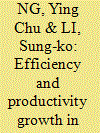| Srl | Item |
| 1 |
ID:
089553


|
|
|
|
|
| Publication |
2009.
|
| Summary/Abstract |
The social science research performance of Chinese universities is examined using panel data. The universities are found to be very inefficient in general, with not much difference between regions. By far the largest single cause of universities? overall technical efficiency is pure technical efficiency, along with a considerable amount of scale inefficiency and a modest amount of congestion. No obvious regional differences in the universities? productivity growth are apparent between 1998 and 2002. Decomposition of the Malmquist productivity index indicates that although there has been technological progress over the years, poor scale efficiency and technical efficiency have resulted in deterioration in the universities? average productivity. There are signs of increasing congestion during the period studied.
|
|
|
|
|
|
|
|
|
|
|
|
|
|
|
|
| 2 |
ID:
136253


|
|
|
|
|
| Summary/Abstract |
To address challenges for the 21st century, the Chinese government initiated a series of higher education reforms to support the open-door policy of China. Part of the education reform involves an allocation of additional funding of US$ 20 billion to a group of 112 universities to strengthen their research capabilities with an ultimate goal for them to become national catalysts for raising Chinese educational standards to world-class quality. The target university group is known as Project 211 universities. Other non-Project 211 universities have not received such resources. This paper is the first to provide rigorous assessment of the impact of the latest higher education reform on the performance of Chinese universities for the period 2007–2009.
Evidence from meta-frontier analysis reveals that the reform had intended impact on the Chinese universities in our sample. Project 211 universities, on average, performed better than the non-Project 211 group and managerial inefficiency is the key attribute of low overall productive efficiency. Unlike Project 211 universities, non-Project 211 universities have limited access to the best available technology. However, the Malmquist productivity index suggests that Project 211 universities experienced more severe productivity regress than non-Project 211 universities. Our mixed evidence may reflect economy-wide conditions and warrant further research. Nevertheless, evidence suggests that the higher education reforms should be broadened to allow non-Project 211 universities to compete with Project 211 universities for additional financial support required to enhance their research capability.
|
|
|
|
|
|
|
|
|
|
|
|
|
|
|
|
| 3 |
ID:
106242


|
|
|
|
|
| Publication |
2011.
|
| Summary/Abstract |
Since the implementation of health care reforms, much has been documented regarding the practices and behavior of hospitals or health profession in China. While these documentations pointed to various problems arising from the reforms, a systematic analysis is rarely found. Based on five years' data, the present study aims at providing empirical evidence of inefficiency of hospitals in China. Using the data envelopment analysis, the sources of inefficiency were examined. Echoing the unnecessary care, over-prescription of drugs and the adoption of high-tech treatments since the implementation of health care reforms, the sampled hospitals were found quite inefficient and pure technical inefficiency played a dominant role in driving the inefficiency of hospitals. Combining the panel nature of the data and the Malmquist Index computation, hospitals had experienced productivity growth between 2004 and 2008. Mirroring the behavior of hospitals, technological progress was the underlying force for the growth and the deterioration in efficiency change was found. The results summarized by region revealed that the stage of economic development and the efficiency performance of hospital did not necessarily go hand in hand.
|
|
|
|
|
|
|
|
|
|
|
|
|
|
|
|